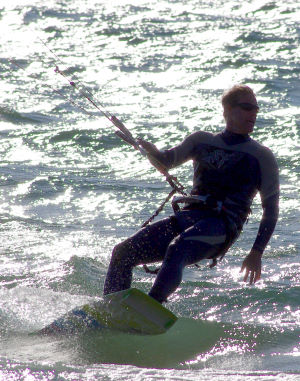How to Go Upwind on Your Kiteboard
How to Go Upwind on Your Kiteboard
by Jake Mitchell
Once you have figured out how to do a successful board start, ride comfortably in either direction, and transition (it doesn't even have to be smoothly yet), it is time to start focusing on kiteboarding upwind. There is nothing more exhausting than walking up the beach several times a session to where you originally started from, only to ride rapidly downwind again and again. It also detracts directly from the amount of time you spend on the water riding and energy put towards progressing. Honestly, you are going to be much less motivated to attempt that new transition or playing in the small waves if it is only hastening your journey downwind and its associated hike back up the shoreline. Thus, learning to ride upwind becomes so much more than dodging the embarrassing "walk of shame", but rather is directly correlated to your rate of early progression. Fortunately, by focusing on a few simple steps, you can be riding upwind in no time and maximizing your sessions!
 Going upwind is as much about form as it is balance. You will want to make sure you are reasonably powered up. Rather than trying to drive upwind immediately, gain some board speed first. If there is small chop or waves, bending your knees as you go over it will help keep traction and maintain board speed. Start the process by shifting even more pressure than usual to your back foot, especially onto your heel. It helps if you turn your foot ever so slightly away from the direction you are traveling in, forcing even greater pressure. While doing this, keep your front leg straight, toes lifted up, using it to steer you upwind. Make sure this doesn't compromise your board speed, or else you are likely edging power out of your kite by forcing it too far forward in the wind window, and are going to end up having to restart the process. It may help to set a target upwind and work towards it. When you look somewhere upwind it causes your shoulders to rotate, which then rotates your hips, turning you into the wind. If you can steer the kite comfortably with one hand, taking your front hand off of the bar will have a similar rotational effect on your body.
Going upwind is as much about form as it is balance. You will want to make sure you are reasonably powered up. Rather than trying to drive upwind immediately, gain some board speed first. If there is small chop or waves, bending your knees as you go over it will help keep traction and maintain board speed. Start the process by shifting even more pressure than usual to your back foot, especially onto your heel. It helps if you turn your foot ever so slightly away from the direction you are traveling in, forcing even greater pressure. While doing this, keep your front leg straight, toes lifted up, using it to steer you upwind. Make sure this doesn't compromise your board speed, or else you are likely edging power out of your kite by forcing it too far forward in the wind window, and are going to end up having to restart the process. It may help to set a target upwind and work towards it. When you look somewhere upwind it causes your shoulders to rotate, which then rotates your hips, turning you into the wind. If you can steer the kite comfortably with one hand, taking your front hand off of the bar will have a similar rotational effect on your body.
Meanwhile, you will want to pay some heed to the power of the kite. You will want the bar somewhere near the middle of the throw to adjust for variances in power. If you catch a slight gust, seize the opportunity to edge even more aggressively upwind while letting the bar out slightly, allowing the kite to fly further forward. Conversely, if you encounter a lull, flatten your kiteboard out to maintain speed. When driving upwind, it helps to keep the kite a little lower to allow it to push forward in the wind window. Once your speed is up, you will want most of the tension in the center lines of the kite, easily tested by wiggling the bar lightly. If there appears to be a lot of tension in the steering lines, you in all likelihood have the bar pulled in too close and are choking the kite.
While it may seem extremely frustrating at first, once you get it, the skill will suddenly click. As with any new trick, keep focusing on the different components individually and then bring them all together. For the visually oriented learners, the below are some useful video companions.
